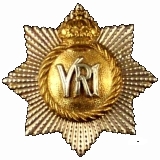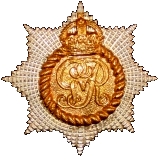
The First World War
An RCR Officer's Diary 1914-1918
MARCH, APRIL 1916
MARCH 1916
A draft of 19 other ranks arrived from England on 1st [Mar, 1916], this was the first draft received by the battalion since arrival in France.
When the 3rd Canadian Division took over a systematic aggressive policy was adopted against the enemy.
On the night of 1st/2nd [Mar] an attack was made on the German trenches south of Ypres, successfully recapturing the "bluff" which had been previously taken by them.
The Brigade "stood to" during the action carrying on a demonstration throughout.
This month compulsory military service came into force in England and Scotland, and a special corps known as the Non Combatant Corps was raised into which the so-called conscientious objectors were drafted. This unit was, however, commanded by Regular officers, and Regular officers and N.C.O's unfit for general service were detailed to do duty with this unit.
The 52nd Cdn Infty Battn of 9th Cdn Infty Bde recently arrived in France were attached to the battalion for instruction in the same manner as the battalion had been attached at Ploegstroet.
The brigade front having again been enlarged the battalion moved north in the vicinity of Kierstraat and relieved 31st Battn on 3rd [Mar]. Twenty thousand pairs of shoepacks, a present from Canada were issued to the Corps. These were found very useful in the trenches, being soft and practically waterproof.
A change was made in the staff distinctions of uniforms worn by officers differentiating between the General and Administrative staff, and the Technical and Departmental Staff.
The General and Administrative staff continued to wear scarlet gorget patches, with scarlet hat band and for field officers the gold leaf peak to the cap. The medical, Army Service Corps, ordnance and like staff wore a blue gorget patch with crimson gimp line, and a blue band round the regimental cap with a regimental badge while certain Instructional, Intelligence and other officers wore a green gorget patch with a green gimp line and a green band on the regimental cap with the regimental badge. Staff officers of the Royal Flying Corps wore French grey gorget patches and a French grey hat band, and those of the Chaplain Department wore black patches and cap bands.
On 7th [Mar] the 25th Cdn Battn (Halifax Rifles) relieved the battalion which marched to Locre, moving the next day to billets at Meteran.
The organization of the Machine Gun Corps was commenced this month. This started by the formation of Machine Gun Companies made up from the withdrawal of the battalion machine guns, and in some cases their crews and transport as well, and by drafts from England.
Each brigade was allotted a Company which consisted of 16 guns and approximately 150 men.
The effect of the formation of this Corps was a concerted machine gun defence for the whole of a Brigade with a continuous policy. The importance of machine guns had grown tremendously during the war and the method of their use revolutionised and developed.
The battalion guns were replaced by Lewis Machine Guns, each battalion being issued with four. This was increased as these new guns became available from the factory and men were trained to handle them up to 16 or one for each platoon. Later, however, these were increased to 32, or two per platoon.
On 14th [Mar] Brig Gen F.O.W. Loomis took over command of the Brigade from Lt Col A.H. Macdonell who returned to the battalion.
About this time the whole battalion was inoculated against para-typhoid, a type of fever which had sprung up in French warfare, these inoculations had to be repeated every 6 months. This was no longer voluntary, an order having been given that all ranks under the age of 45 must be inoculated.
Capt Willoughby left for the 9th Scottish Division as a staff learner. Capt V. Hodson assuming duties as Adjutant.
Lt Gen Alderson visited the battalion in billets prior to moving to the Ypres Salient. All winter kit was turned in before moving. Transport was a very difficult problem in Winter time for although all manner of extra clothing and equipment was issued for sedentary warfare yet no extra transport was given to carry it in. this necessitated hiring civilian farm carts or when possible by making two journeys.
On 20th [Mar] the Battalion matched to "C" Camp Busselboom on Brigade Reserve, relieving the 17th British Brigade, 24th Division. Owing to heavy rain on top of the snow lying on the ground the state of the Camp was almost as bad as that of La Clytte in November.
On 25th [Mar] the battalion relieved 42nd R.H.C. In Sanctuary Wood and Maple Copse east of Zillebeke having moved by train as far as Ypres. On the right were the Northumberland Fusiliers of 5th Division and on the left P.P.C.L.I.
German patrols had been dominating no man's and, sniping and hostile shelling was very bad. The enemy would even shell two and sometimes only one man is he showed himself even well behind the line. In fact, owing to the semi-circular and dominating position of the enemy nothing could be done by day or hostile actions was very severe at night.
When the 3rd Canadian Division took over a systematic aggressive policy was adopted against the enemy. Active patrolling was carried out and well-planned harassing fire was conducted by the Lahore Divisional Artillery which had been attached to the 3rd Canadian Division.
On 27th [Mar] a German patrol of abut 20 were dispersed by our Lewis Gun fire. Later the same night one of our patrols entered and thoroughly reconnoitred one of the enemy's advanced trenches. From this time onwards it may be said that our men had driven the Germans off no man's land.
The following morning abut 4.20 a.m. a terrific explosion followed by a very heavy bombardment was heard immediately to the South. This was the beginning of the fight for St. Eloi, the craters of the German mines which was the commencement of the action playing a very important part in the fighting for many weeks.
Many devices were tried out at this time with a view to giving the men in the front lines hot meals.
There were two methods of feeding in the trenches, one where company cooks prepared a hot meal just behind or even in the front line trenches and one where each man prepared his own meal. While the former resulted in a properly cooked meal, the latter occupied and interested the man.
Containers of various patterns were issued to carry hot food up and about the trenches, these originated from an improvised container made by 2nd Bn Worcestershire Regt who made a box with rope handles and lined it with sandbags upholstered with straw.
On 29th [Mar] the battalion returned to Busseboom Rest Camp.
R.S.M. Phillips and Sergt Maj (O.R.C.) H.J. Beard were promoted Lieutenants.
APRIL 1916
On 5th [Apr] the battalion moved from Busseboom to Belgian Chateau south of Ypres on Zillebeke Dugouts relieving 4th Cdn Mounted Rifles. Relieving 42nd R.H.C. The battalion moved to left or north of Sanctuary Wood into the Appendix on 13th [Apr]. P.P.C.L.I. were on the left at Hooge and 1st Cdn Mtd Rifles on the right. While at Belgian Chateau considerable casualties were caused by hostile shell fire.
On 16th [Apr] Lt Col A.H. Macdonell, D.S.O., was promoted Brigadier General Commanding 5th Cdn Infty Brigade. Major Eaton assumed command of the battalion.
About this time the appointment of Brigade Machine Gun officer was abolished on the formation of the Machine Gun Corps. In most cases the officer holding the appointment was given command of the Brigade Machine Gun Company, Capt H.T. Cock was so appointed.
On 29th [Apr] Major C.H. Hill was appointed to command the battalion.
Lieut Penniman joined the battalion with 85th (sic) other ranks, and Lieuts V. Heron, W. Davis, J.S. Woods, G. Dwyer, H.P. Bell, and T.F. Morrison reported from England. Lieut de Salis proceeded to Havre on Instructional work while Capts Balders and Holloway and Lts McCrea, Campbell and C.L. Wood were invalided to England.
On 21st [Apr] the battalion having been relieved by 43rd Canadian Battalion (9th Cdn Infty Bde) returned to Camp "E", Busseboom. Three days later hostile aircraft bombed the camp. One bomb hit a hut killing 10 men and wounding 24, this was the first occasion on which Rest Camps had been bombed. Lewis and Machine Guns were immediately posted in various parts of the Camp for Anti-Aircraft purposes.
It is interesting to note how closely guns have been identified with battalions at various intervals for their immediate protection. Even in the Napoleonic Wars two brass 6-pdr guns formed part of the establishment of a battalion of infantry.
The Commander-in-Chief Sir Douglas Haig inspected the Brigade Area on 28th [Apr]. The following day the enemy carried out a gas attack on Spanbroek Molen in front of Kemmel Hill, the various gas alarms which had been placed wherever it was possible for gas to lie were sounded passing right and left front and rear in an incredible short time.
- The O'Leary Collection; Medals of The Royal Canadian Regiment.
- Researching Canadian Soldiers of the First World War
- Researching The Royal Canadian Regiment
- The RCR in the First World War
- Badges of The RCR
- The Senior Subaltern
- The Minute Book (blog)
- Rogue Papers
- Tactical Primers
- The Regimental Library
- Battle Honours
- Perpetuation of the CEF
- A Miscellany
- Quotes
- The Frontenac Times
- Site Map

![]() The RCR in the Great War
The RCR in the Great War
![]() War Diary
War Diary
![]() Battle Honours
Battle Honours
![]() Battle Bars and The RCR
Battle Bars and The RCR
![]() The RCR Battle Bar Ledger (pdf)
The RCR Battle Bar Ledger (pdf)
![]() Honours and Awards
Honours and Awards
![]() Roll of Honour
Roll of Honour
![]() Prisoners of War
Prisoners of War
![]() Cemetery List
Cemetery List
![]() Cemetery Map
Cemetery Map
![]() Courts Martial
Courts Martial
![]() Officers
Officers
![]() RSMs of The RCR (1914-1919)
RSMs of The RCR (1914-1919)
![]() NCOs and Soldiers
NCOs and Soldiers
![]() An Officer's Diary (1914-1918)
An Officer's Diary (1914-1918)
![]() Recollections of a Nonagenerian (R. England) (1916-1919)
Recollections of a Nonagenerian (R. England) (1916-1919)
![]() On to Bermuda (1914-15)
On to Bermuda (1914-15)
![]() England and France 1915-1916 (Hayes; 1931)
England and France 1915-1916 (Hayes; 1931)
![]() Overseas with The Royals (1915)
Overseas with The Royals (1915)
![]() Regimental History Pamphlet (1917)
Regimental History Pamphlet (1917)
![]() Amiens (1918)
Amiens (1918)
![]() Cambrai (1918)
Cambrai (1918)
![]() Monchy-le-Preux (1918)
Monchy-le-Preux (1918)
![]() Under-aged Soldiers in The RCR
Under-aged Soldiers in The RCR
![]() Not All Were Volunteers; The RCR and the Military Service Act
Not All Were Volunteers; The RCR and the Military Service Act
![]() Sentenced to Death by Court Martial
Sentenced to Death by Court Martial
![]() The 7th Trench Mortar Battery
The 7th Trench Mortar Battery
![]() A Regimental Goat
A Regimental Goat
![]() Regiment and Family, Bermuda 1914-15
Regiment and Family, Bermuda 1914-15
![]() "March the Guilty Bastard In"
"March the Guilty Bastard In"
![]() Surrendered as Stowaway
Surrendered as Stowaway
![]() Re-Visiting the Great War Roll of Honour for The RCR
Re-Visiting the Great War Roll of Honour for The RCR
![]() Canadian Corps Trench Standing Orders (1916)
Canadian Corps Trench Standing Orders (1916)

